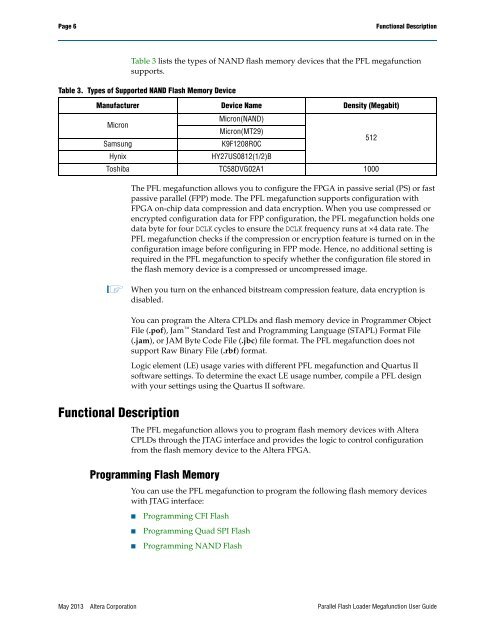Parallel Flash Loader Megafunction User Guide (PDF) - Altera
Parallel Flash Loader Megafunction User Guide (PDF) - Altera
Parallel Flash Loader Megafunction User Guide (PDF) - Altera
You also want an ePaper? Increase the reach of your titles
YUMPU automatically turns print PDFs into web optimized ePapers that Google loves.
Page 6<br />
Functional Description<br />
Table 3 lists the types of NAND flash memory devices that the PFL megafunction<br />
supports.<br />
Table 3. Types of Supported NAND <strong>Flash</strong> Memory Device<br />
Manufacturer Device Name Density (Megabit)<br />
Micron(NAND)<br />
Micron<br />
Micron(MT29)<br />
512<br />
Samsung<br />
K9F1208R0C<br />
Hynix<br />
HY27US0812(1/2)B<br />
Toshiba TC58DVG02A1 1000<br />
The PFL megafunction allows you to configure the FPGA in passive serial (PS) or fast<br />
passive parallel (FPP) mode. The PFL megafunction supports configuration with<br />
FPGA on-chip data compression and data encryption. When you use compressed or<br />
encrypted configuration data for FPP configuration, the PFL megafunction holds one<br />
data byte for four DCLK cycles to ensure the DCLK frequency runs at ×4 data rate. The<br />
PFL megafunction checks if the compression or encryption feature is turned on in the<br />
configuration image before configuring in FPP mode. Hence, no additional setting is<br />
required in the PFL megafunction to specify whether the configuration file stored in<br />
the flash memory device is a compressed or uncompressed image.<br />
1 When you turn on the enhanced bitstream compression feature, data encryption is<br />
disabled.<br />
You can program the <strong>Altera</strong> CPLDs and flash memory device in Programmer Object<br />
File (.pof), Jam Standard Test and Programming Language (STAPL) Format File<br />
(.jam), or JAM Byte Code File (.jbc) file format. The PFL megafunction does not<br />
support Raw Binary File (.rbf) format.<br />
Logic element (LE) usage varies with different PFL megafunction and Quartus II<br />
software settings. To determine the exact LE usage number, compile a PFL design<br />
with your settings using the Quartus II software.<br />
Functional Description<br />
The PFL megafunction allows you to program flash memory devices with <strong>Altera</strong><br />
CPLDs through the JTAG interface and provides the logic to control configuration<br />
from the flash memory device to the <strong>Altera</strong> FPGA.<br />
Programming <strong>Flash</strong> Memory<br />
You can use the PFL megafunction to program the following flash memory devices<br />
with JTAG interface:<br />
■<br />
■<br />
■<br />
Programming CFI <strong>Flash</strong><br />
Programming Quad SPI <strong>Flash</strong><br />
Programming NAND <strong>Flash</strong><br />
May 2013 <strong>Altera</strong> Corporation <strong>Parallel</strong> <strong>Flash</strong> <strong>Loader</strong> <strong>Megafunction</strong> <strong>User</strong> <strong>Guide</strong>
















